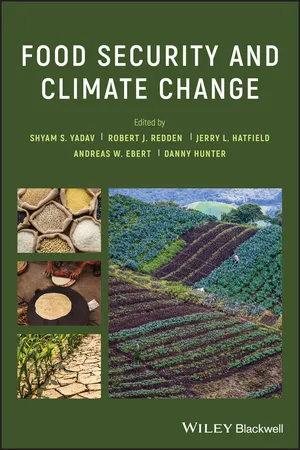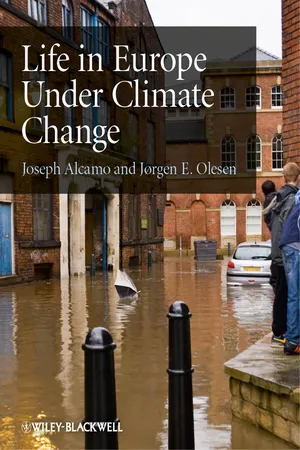Geography
Agriculture and Climate
Agriculture and climate are closely interconnected, as climate factors such as temperature, precipitation, and extreme weather events significantly impact agricultural productivity. Changes in climate patterns can lead to shifts in suitable growing regions, affecting crop yields and food security. Adaptation strategies, such as crop diversification and water management, are crucial for mitigating the effects of climate change on agriculture.
Written by Perlego with AI-assistance
Related key terms
4 Key excerpts on "Agriculture and Climate"
- eBook - ePub
- Shyam Singh Yadav, Robert J. Redden, Jerry L. Hatfield, Andreas W. Ebert, Danny Hunter(Authors)
- 2018(Publication Date)
- Wiley-Blackwell(Publisher)
It is also well recognized that agriculture sectors are directly affected by changes in temperature, precipitation, and carbon dioxide (CO 2) concentration in the atmosphere. Thus, early and bold measures are needed to minimize the potentially drastic climate impacts on the production and productivity of various field crops. In most of the developing countries in Africa, Asia, and Asia Pacific regions, about 70% of the population depend directly or indirectly for its livelihood on the agriculture sector and most of this population lives in arid or semiarid regions, which are already characterized by highly volatile climate conditions (Yadav et al., 2015). Food, from staple cereal grains to high protein legumes and oilseed crops, is central to human development and well‐being (Misselhorn et al., 2012); however, the complexity of global food security is challenging and will be made more so under climate change. The world continues to face huge difficulties in securing adequate food that is healthy, safe, and of high nutritional quality for all (Redden et al., 2014a). Considering the complexity of climatic change, the crop, plants, and livestock are inherently affected by too much or too little water, too high or too low temperatures, the length of the growing season, seasonal variation, other climatic extremes, etc. If we consider weather extremes during 2010 – 11, in Russia there were severe heat waves and approximately 30% of grain crops were lost due to burning, which resulted in huge losses to the Russian economy. Likewise, in Pakistan, the worst floods in 80 years of history occurred, and it was suggested in different media reports that one–fifth of the country area and more than 14% of cultivated land were submerged - eBook - ePub
- Joseph Alcamo, Jorgen E. Olesen(Authors)
- 2012(Publication Date)
- Wiley-Blackwell(Publisher)
4 Food productionIntroduction How does climate affect crops? What determines crop production in Europe? How will individual crops be affected?IntroductionArable crops Perennial crops GrasslandsHow will livestock be affected? Other impacts on agroecosystemsWeeds, pests and diseases Soils Environmental impactsExtreme events and climatic variability How can agriculture adapt to climatic change?Autonomous adaptation Planned adaptation Increasing resilience to changeHow will fisheries be affected?Marine ecosystems Aquaculture AdaptationHow will food systems be affected? NotesEurope is a very culturally diverse continent. This is not the least reflected in the traditional diet and food habits of Europeans in different regions. Traditionally, dairy and livestock products play a large role in the diet in northern Europe, whereas fresh vegetables, grains and legumes, in combination with a wide range of fish and livestock products, form the basis of the Mediterranean kitchen. In central and eastern Europe soups are an essential part of the diet. All of this reflects the differences in culture and climate throughout Europe; and even widespread globalization has not been able to erase these cultural differences. The diet of all European countries has been converging over the past few decades, and the average calorie intake is now 20% above the recommended level.1 This is largely a result of technological improvements in livestock production, which provides animal protein and fat at very low costs. In contrast, some of the traditional European foods are more expensive to produce, and it is probably these local and often protected foods that will primarily be affected by climate change.The countryside of Europe will also look different in the future. As the climate becomes wetter and warmer north of the Alps, fields of sunflower and maize will begin appearing where earlier they could not flourish. Even vineyards will become successful far further north than anyone can remember. Meanwhile, after decades of consistently drier and hotter conditions, many farmers south of the Alps and in the Balkans will either adapt by adopting a much less productive agriculture, or they may simply give up, and abandoned agricultural land could then become a prominent feature of the landscape. - eBook - ePub
The Political Ecology of Climate Change Adaptation
Livelihoods, agrarian change and the conflicts of development
- Marcus Taylor(Author)
- 2014(Publication Date)
- Routledge(Publisher)
Climate, capital and agrarian transformationsAlthough climate change adaptation is a relatively new entrant into the contemporary governmental lexicon, the projection of encompassing transformations onto agrarian environments is conspicuously familiar. From the colonial period to the present, rural peoples have repeatedly found themselves as the object of state-driven projects to intensify agricultural production, more fully integrate producers into national and international divisions of labour and mediate the political discontents that such processes entail. In the present chapter, I map out how the idea and practices of climate change adaptation are situated within this wider context. I argue that there are two parallel narratives of agrarian transformation at work that, despite being held at arm’s length, are duly complementary. The first is the standard rubric of adaptation introduced in the previous chapters. This narrative represents agrarian regions as spaces that are disproportionately vulnerable to climatic threats. Arun Agrawal and Nicolas Perrin, for example, highlight a catalogue of incipient risks facing natural resource-dependent households, including “droughts, famines, floods, variability in rainfall, storms, coastal inundation, ecosystem degradation, heat waves, fires, epidemics, and even conflicts” (2008: 1). The idea of adaptation is then called into being as a series of planned social adjustments to mediate such proximate climatic disturbances, including institutional changes, infrastructure building, the diffusion of new technologies and social reforms. Collectively, these adaptation processes are intended to guard against the threats posed by climatic change.Alongside this account of adaptation as a form of risk mitigation, however, there exists a corresponding institutional narrative of agrarian transformation that coheres around climate change as a threat to global agricultural production and food security. In this framing, the object of adaptation is agriculture as an economic sector and the source of food for an expanding and increasingly urbanised global population with changing consumption habits. While the first narrative is immediate, localised and reactive, the second is explicitly posited as a vision of socio-economic transformation on a wider temporal and spatial scale. Framed in neo-Malthusian terms of population pressures and future food scarcity, it articulates the need for deep-seated changes to global agriculture that are rendered ever more pressing by the spectre of climate change: - eBook - ePub
- Heinrich Wohlmeyer, Theodor Quendler(Authors)
- 2017(Publication Date)
- Routledge(Publisher)
Some of the above-mentioned arguments have already shown implicitly that agriculture produces ‘by-products’ during the production process for which farms are not paid. In economic theory benefits that occur as by-products during the economic production process and that are consumed by the public without rewarding the producer are called ‘positive externalities’. Such effects are not to be found exclusively in agriculture and are therefore not to be seen as an argument for giving this sector a special status. Still, it seems unambiguous and unanimously agreed that in the case of agriculture the extent of the effects and the number of beneficiaries seem to be somewhat remarkable.The relevant questions concerning agricultural production and its contributions to the protection and preservation of the environmental media—soil, water, air and biodiversity—will be dealt with in Chapter 13 . In what follows we deal with two other major benefits: the preservation of the cultural landscape, and risk management.Generally speaking, cultural landscapes are defined as landscapes shaped and maintained by human activity. Agricultural landscapes, which have been shaped by agricultural activity for centuries, constitute a major category of such landscapes. As well as the economic value of food production, the following values are typically derived from such landscapes:- Leisure value (contribution of the landscape to human health and human well-being)
- Aesthetic, cultural and historical values
- Biological and ecological values
These values are sustained by an agricultural production method adapted to the specific landscape and its environmental conditions. They are to be seen as by-products that cannot be decoupled from agricultural activity.Turning to risk management, it is important to recognise that prolonged agricultural production is synonymous with a minimisation of risk. It minimises the risk of food shortage arising from a cut in food imports—something that may become increasingly important in the context of a higher potential incidence of crop failures resulting from climatic change and severe weather events (e.g. floods and hurricanes). It also minimises the risk of losing know-how about agricultural production methods and specifically adapted cultivation techniques over time. Such knowledge, which in many cases is based on working experience, could be regained only in the long run. Its loss threatens food shortages if production, having once stopped, must be abruptly restarted. The risk of food shortage as a result of political unrest or logistical breakdowns tends, today, to be underestimated. The tendency is to centralise the logistics of food-supply operations and to decrease national buffer stocks, which increases national vulnerabilities to any supply problems.
Learn about this page
Index pages curate the most relevant extracts from our library of academic textbooks. They’ve been created using an in-house natural language model (NLM), each adding context and meaning to key research topics.



